Can you guess what movie or TV show we’re watching? We’ve turned on subtitles (when available) not to give you a clue, but to enhance that WTF effect! Leave your best guess in the comments to prove your true Flick Attackosity!
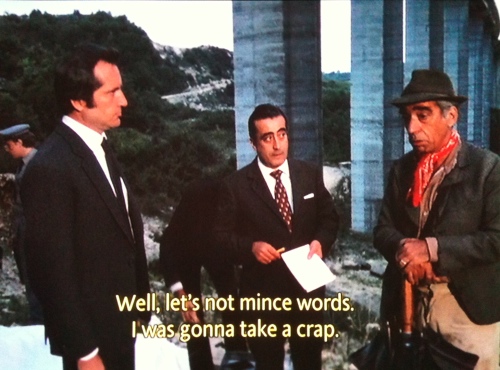
Can you guess what movie or TV show we’re watching? We’ve turned on subtitles (when available) not to give you a clue, but to enhance that WTF effect! Leave your best guess in the comments to prove your true Flick Attackosity!


 Women. Don’t listen to ’em. Snake-wranglin’ John Rambo (Sylvester Stallone) doesn’t when Colorado church missionary member Sarah (Julie Benz) comes to Thailand to ask him to take her team to Burma. He turns her down because it’s a literal war zone. She pleads. He says no. She pleads again. He says no. She pleads again. He says no. She pleads even more. He says “oh, alright,” probably just to shut her up.
Women. Don’t listen to ’em. Snake-wranglin’ John Rambo (Sylvester Stallone) doesn’t when Colorado church missionary member Sarah (Julie Benz) comes to Thailand to ask him to take her team to Burma. He turns her down because it’s a literal war zone. She pleads. He says no. She pleads again. He says no. She pleads again. He says no. She pleads even more. He says “oh, alright,” probably just to shut her up.
And then what happens? Just what he said would: The Christians are either killed or kidnapped by Burmese rebels. And Rambo is asked by the pastor (Ken Howard) to take a group of mercenaries there to save them. At least that allows Rambo — in Rambo, the fourth in the franchise — to do what he does best: slaughter foreigners. Way to go, Julie Benz, you’ve now got the blood of hundreds on your hands. Women.
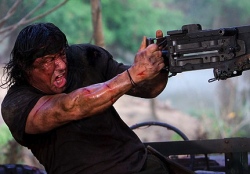 In all seriousness, the 20-year gap between Rambo III and this comeback vehicle works to the action extravaganza’s benefit. Namely, CGI allows Stallone to make this rumble in the jungle as vile and violent as he wanted. Heads roll. Arms and legs fly. Torsos explode. Burma, shaved.
In all seriousness, the 20-year gap between Rambo III and this comeback vehicle works to the action extravaganza’s benefit. Namely, CGI allows Stallone to make this rumble in the jungle as vile and violent as he wanted. Heads roll. Arms and legs fly. Torsos explode. Burma, shaved.
It may seem crass to use a real-life genocide as the jumping-off point for a Hollywood blockbuster, but it does shed a beam of awareness on a problem of which popcorn-munchers likely were ignorant. For Stallone, doing so lets him engage in a wish-fulfillment fantasy, doing things onscreen he cannot do off. Don’t worry, action fans: The politics behind it are splattered — if not all but obscured — with the red stuff. Mass extermination: That’s entertainment! —Rod Lott
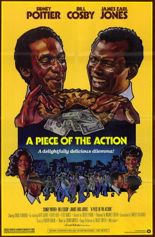
 As an actor, Sidney Poitier is an icon, a living legend, and one of the most important performers in the history of cinema, but as a director, he left a lot to be desired. The success of his biggest hit, Stir Crazy, had far more to do with the chemistry of stars Gene Wilder and Richard Pryor than anything he brought to the table, while Ghost Dad, his fourth collaboration with fellow icon, living legend, etc., Bill Cosby, is remembered only as one of the worst movies of the early ’90s (although such is Poitier’s bulletproof pop-culture status, few are aware he had anything to do with it).
As an actor, Sidney Poitier is an icon, a living legend, and one of the most important performers in the history of cinema, but as a director, he left a lot to be desired. The success of his biggest hit, Stir Crazy, had far more to do with the chemistry of stars Gene Wilder and Richard Pryor than anything he brought to the table, while Ghost Dad, his fourth collaboration with fellow icon, living legend, etc., Bill Cosby, is remembered only as one of the worst movies of the early ’90s (although such is Poitier’s bulletproof pop-culture status, few are aware he had anything to do with it).
Poitier’s third go-round with Cosby, A Piece of the Action (it followed 1974’s Uptown Saturday Night and 1975’s Let’s Do It Again) is about a million times better than Ghost Dad, but that doesn’t stop it from being a bizarre amalgamation of blaxploitation crime comedy and serious social-message movie. The first and best part is a comedic thriller about a thief (Cosby) and con man (Poitier) whose past crimes cause them to be at the mercy of both a retired police detective (James Earl Jones) and the local mobsters whom Poitier once ripped off to the tune of $400,000.
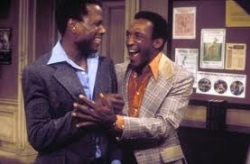 The second part, which bears the clear mark of Poitier collaborator Stanley Kramer (Guess Who’s Coming to Dinner and The Defiant Ones) deals with Poitier’s To Sir, with Love-esque attempts to teach a group of “Afro-American” teenagers how to become desirable job candidates, when he and Cosby are blackmailed by Jones to perform community service for a local charity organization. While this portion is a tad earnest and preachy, it’s far from unbearable. The problem is that for all of the time we spend with it, it never connects with the events from the first half, thereby feeling tacked-on and unnecessary. Add romantic subplots for both protagonists, and it’s amazing the film isn’t longer than its already overstuffed 135 minutes.
The second part, which bears the clear mark of Poitier collaborator Stanley Kramer (Guess Who’s Coming to Dinner and The Defiant Ones) deals with Poitier’s To Sir, with Love-esque attempts to teach a group of “Afro-American” teenagers how to become desirable job candidates, when he and Cosby are blackmailed by Jones to perform community service for a local charity organization. While this portion is a tad earnest and preachy, it’s far from unbearable. The problem is that for all of the time we spend with it, it never connects with the events from the first half, thereby feeling tacked-on and unnecessary. Add romantic subplots for both protagonists, and it’s amazing the film isn’t longer than its already overstuffed 135 minutes.
Despite this, A Piece of the Action is worth seeking out. The only frustration that comes from watching it is the knowledge that if someone at Warner Bros. had the balls to tell its director to cut 40 minutes from the running time, a good film might have become great one. But then again, who among us would have the balls to tell Sidney Fucking Poitier to do anything he didn’t want to do? —Allan Mott
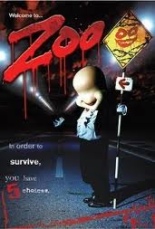
 Not to be confused with the horse-fucking documentary of the same name, Japan’s Zoo is a horror anthology culled from the works of the country’s uni-monikered Otsuichi, presumably a Stephen King of sorts. You wouldn’t know this from the film, which has no wraparound story or any system of linkage, nor the freaky, faceless guide pictured on its cover, which it could use. Each helmed by different directors, the five tales vary in length, style and quality; only one is excellent, while another is an utter chore.
Not to be confused with the horse-fucking documentary of the same name, Japan’s Zoo is a horror anthology culled from the works of the country’s uni-monikered Otsuichi, presumably a Stephen King of sorts. You wouldn’t know this from the film, which has no wraparound story or any system of linkage, nor the freaky, faceless guide pictured on its cover, which it could use. Each helmed by different directors, the five tales vary in length, style and quality; only one is excellent, while another is an utter chore.
“Kazari and Yoko” is a solid opener, a tale of two sisters who couldn’t be more different, despite being twins. Kazari is beautiful and doted upon by their mother; Yoko is treated literally like a dog and often abused. One day, Yoko decides to play a trick, and it’s as crafty as the segment overall. By contrast, the closing story, “Zoo,” is the worst of a bunch. Its elongated plot finds a guy killing his girlfriend at an abandoned zoo, then returning every day to take a Polaroid of her maggoty corpse so he can make a flipbook. It also has something to do with a zebra, and it doesn’t help that it’s purposely shot on ultra-grainy video.
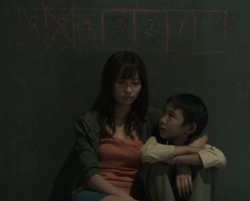 “So Far” is a quasi-ghost story that goes on too long, with a twist that mitigates any power. It examines what happens when an only child’s parents are killed in a car crash, but return as ghosts, only unable to be seen or heard by the other spouse. “The Poem of Collected Sunlight” stands out, but only because it’s animated. The two-character bit is like the Frankenstein myth rendered as a tonal piece.
“So Far” is a quasi-ghost story that goes on too long, with a twist that mitigates any power. It examines what happens when an only child’s parents are killed in a car crash, but return as ghosts, only unable to be seen or heard by the other spouse. “The Poem of Collected Sunlight” stands out, but only because it’s animated. The two-character bit is like the Frankenstein myth rendered as a tonal piece.
“Seven Rooms” makes the entire film worthy of existence, as a little boy and his older sister awake in a locked room with a dirt floor and concrete walls, with no recollection of getting there, nor much hope for escape. It’s like a combination of Cube and those ones with the chainsaw. Now, nothing about “Seven Rooms” (or any of Zoo, for that matter) is scary, but it’s packed with mystery, suspense and ingenuity — elements most of the other segments severely lack. —Rod Lott
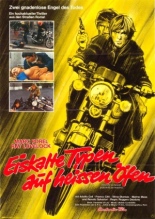
 One would expect Ruggero Deodato, the director of the notoriously nihilistic Cannibal Holocaust, to bring something different to an Italian cop film. In Live Like a Cop, Die Like a Man, he does just that: basic disregard for human life. Enjoy!
One would expect Ruggero Deodato, the director of the notoriously nihilistic Cannibal Holocaust, to bring something different to an Italian cop film. In Live Like a Cop, Die Like a Man, he does just that: basic disregard for human life. Enjoy!
The best part of this crime story comes right out of the gate, as thieving hoodlums on a motorcycle drag an innocent woman along the city sidewalks, because her purse is chained to her wrist. Plainclothes buddy cops Alfredo (Marc Porel) and Antonio (Ray Lovelock) witness this, setting off an ass-kicking, near-10-minute motorcycle chase through the streets (partly shot with no permits). When they catch up to the crashed bandits, only one survives; rather than arrest him, they snap his neck. Justice!
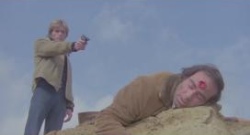 Mind you, this is merely the first scene in a film full of “shoot first, fuck questions” scenarios. We simultaneously root for and abhor Alfredo and Antonio as they go about their really lethal-weapon ways. They rest only long enough to sexually harass women, pestering them for threesomes or sometimes not bothering to ask at all. Chivalry!
Mind you, this is merely the first scene in a film full of “shoot first, fuck questions” scenarios. We simultaneously root for and abhor Alfredo and Antonio as they go about their really lethal-weapon ways. They rest only long enough to sexually harass women, pestering them for threesomes or sometimes not bothering to ask at all. Chivalry!
All of these elements combine for a one-of-a-kind experience, albeit bookended by ill-fitting, Yankee folk ballads of the era. Our poliziotti violenti anti-heroes play like Starsky & Hutch with undiagnosed pathological problems, where blowing up a bunch of people just seems like a really good joke to amuse themselves. And you. Kaboom! —Rod Lott